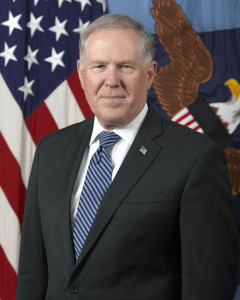

Frank Kendall, DoD’s undersecretary for acquisition, technology and logistics, clarifies new rules about public funding as the Pentagon begins investing in...
The Defense Department’s top acquisition official continued to allay industry fears about department oversight of independent research and development during a Sept. 2 speech in Arlington, Virginia.
DoD’s increased surveillance of independent research and development (IRAD) funding is not trying to dictate what investments industry makes, said Frank Kendall, DoD’s undersecretary for acquisition, technology and logistics during a talk sponsored by the Professional Services Council, an industry association.

The remarks come at a time when the Pentagon is throwing its weight into research and development investments in Silicon Valley to spur technological innovation.
DoD released a white paper Aug. 26 clarifying the section in DoD’s newest acquisition guidance, Better Buying Power 3.0, that was interpreted by some to be a judgment of IRAD projects by Defense acquisition officials before research is started. That review stage would add time and cost to industry research and development.
The paper assured industry that DoD was not trying to strong-arm industry, but rather ensure a two-way dialogue that would provide for some minimum oversight. The white paper requires industry to brief someone in the department before and after an IRAD project, Kendall said.
“This does not require government approval, it does not require government sponsorship per se of the work,” Kendall said. “I think that’s a minimum requirement.”
DoD implemented the provision as a means of cracking down on industry’s use of public funds for near-term goals, like reducing the price on a competitive item, and not to actually create intellectual property. The Pentagon felt there was a disconnect between what the government was expecting and what industry was providing. As a result, DoD required reviews to ensure it was aware of industry’s goals and plans for a project before funding it.
“What I am looking for … is that there is some meaningful technical content in the award that’s been put out, that’s really the fundamental point,” Kendall said. “By requiring industry to tell government what it’s doing will encourage more meaningful content.”
IRAD accounts for about $4 billion of total research and development spending, according to DoD.
While the Pentagon is trying to ease industry’s IRAD worries, Kendall said he is being pulled in two directions internally and by Congress over the commercial practices in purchasing.
“We’ve tried to strike the right balance here. We would prefer to buy things that are commercial, commercially. And that’s what we do,” Kendall said. It’s the items that are in the gray area between purely military and commercial that continue to pose a problem, he added.
He said he has heard from the DoD inspector general that the Pentagon is paying too high of margins, but has also heard complaints from industry about how hard it is to provide cost data.
As a result, DoD has implemented some drafts for better commercial buying and is soliciting feedback.
“I’m very open to input on this,” Kendall said. “I’m really trying to strike the right balance. I think we’re pretty close and we are kind of tweaking things on the edge a little bit. We are trying some things that make it easier to do business and easier to get these determinations.”
DoD is putting teams together through the Defense Contract Management Agency that will assist companies as they try to determine prices and make determinations of what is commercial.
Even though DoD is making efforts to improve its procurement and research investments, Kendall said the threat of a continuing resolution or sequestration seriously harms the health of the department.
“I don’t know where we are going,” Kendall said.
The difference between a continuing resolution or sequestration, and the President’s budget is about $40 billion. About half of that would be taken out of products and services acquired by DoD.
Kendall said if a continuing resolution is enacted for fiscal 2016 then the department will keep its spending down so it will not have a repeat of 2013.
“I have never seen in my history in Defense such a disconnect between the problems we are trying to address in national security and the resource levels that we are being given,” Kendall said.
Copyright © 2025 Federal News Network. All rights reserved. This website is not intended for users located within the European Economic Area.
Scott Maucione is a defense reporter for Federal News Network and reports on human capital, workforce and the Defense Department at-large.
Follow @smaucioneWFED

